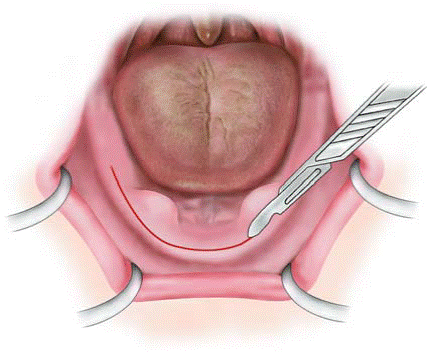Mandibular tori are usually present on the tongue side of the jaw near the bicuspids (also known as premolars). They usually 90% of the time occur on both sides of the mouth (bilaterally).
Torus mandibularis or mandibular torus, tori mandibularis for plural, is a sublingual protuberance or a benign bony growth occurring on the mandible lingual side. Around 80% to 90% of these lesions present bilaterally near the bicuspid and tricuspid teeth and superior to the mylohyoid muscle, a paired muscle for mandibular attachment.
The prevalence of mandibular tori ranges from 5% – 40%. It is less common than bony growths occurring on the palate, known as torus palatinus. Mandibular tori are more common in Asian and Inuit populations, and slightly more common in males. In the United States, the prevalence is 7% – 10% of the
Mandibular tori are more common in Asian and Inuit populations, and slightly more common in males. In the United States, the prevalence is 7% – 10% of the population.
Mandibular tori are usually a clinical finding with no treatment necessary. It is possible for ulcers to form on the area of the tori due to trauma. The tori may also complicate the fabrication of dentures. If removal of the tori are needed, surgery can be done to reduce the amount of bone, but the tori may reform in cases where nearby teeth still receive local stresses.
Tori Dental Causes, Removal Surgery, Cost
Tori are simply bony growths in the upper or lower jaws. Mandibular tori gradually grow as nodular multilobulated mass occurring as single or multiple growths usually limited up to 2mm in size with largest documented diameter of 3 to 4cm. the growth size of these lesions vary but is some cases, the masses can grow large enough toward midline of the mouth. The direct cause of torus mandibularis is still unknown although several factors are believed to contribute to its occurrence.
What is Tori Dental (torus mandibularis)
Tori or “Dental Torus” are benign bony growths of the mouth, especially of the lower mandible. Tori of the lower jaw are called mandibular torus or bone exostoses. Tori bumps can grow high or low in the mouth, and don’t require removal except in preparation of headgear braces denture fitting. These abnormal bone protrusions grow larger with age. Large tori in older patients can interfere with fitting upper or lower dentures, and should be removed
Torus Mandibularis Causes
The exact cause of torus mandibularis is not known. However, there are many factors which may trigger such growths
- The bony growth has genetic origins and passes on with an autosomal dominant pattern. It is more prevalent in Inuits, Koreans, and other Asians.
- The condition is more common in men and the average age of onset is between 40 and 50 years. In adults, the incidence rate of torus mandibularis lies between 12.2 percent and 27 percent, while it is very rare and low in children at just 3 percent.
- It is also though that teeth grinding can trigger the formation of such bony growths. Masticatory stress and teeth grinding tend to add to the occolusal load, especially in individuals who eat a coarse and granular diet. The consequent increased pressure and force on the periodontal ligament can then activate the formation of the new bone on the inner surface of the lower jaw near the premolar region.
- The bony growths may also appear after a prolonged period of elevated stress levels.
- Torus mandibularis may sometimes occur along with underling conditions like abscess formation, bone cancer, salivary gland tumors, vascular tumors, and fibromas.
- Removal of the growths does not necessarily prevent them from growing once again. Thus, their reoccurrence is an indication that it can be part of the continuous process of bone formation in the oral cavity instead of being a onetime defect.
Torus Mandibularis Removal Surgery
Mandibular tori surgery is a rare oral surgery that consists of the removal of excess bone in the mouth. Patients suffering from this excess jaw bone receive great benefits from this surgical procedure. As with most oral surgery, the cost for mandibular tori surgery in the US is too high for most patients. Many patients consider Los Algodones for this surgery, due to high quality dental care and prices that are often 50% less than prices for the same treatment in the USA and Canada.
Torus Mandibularis Removal Cost
Dental prices vary a lot in each city. You can typically save money by using your dental insurance network or by joining a dental discount plan. Torus mandibularis removal costs $585. The Fair Price is the price that you should reasonably expect a medical service to cost if you shop for care.




I have tori dental in the top of the roof in my mouth about 3/4 way back. I’m at 39 years old I recently have self diagnosed also hyperdontia. At 39 I have a tooth coming in on the top and has broke through the roof of my mouth and causing strangest nerve sensation and pressure when just resting tongue to roof of mouth. I’m told it’s not necessary to have removed unless it’s cauaing problem. Oh but it is. Badly. On top all this I have no insurance and have to pay outta pocket Bc Medicare don’t cover dental But hyperdontia is preventive care I’m told. Anyhow I’d attach photos as well but doesn’t allow me. Help. 39 female Caucasian in Cortland,Ny who has no one to turn to